The beverage packaging market is valued at USD 142.7 billion in 2025 and is projected to reach USD 230.2 billion by 2035, rising at a 4.9% CAGR, adding USD 88.7 billion in total growth. Expansion is steady and driven by rising global consumption of packaged beverages, the surge in on-the-go formats, and increasing demand for premium bottled products across soft drinks, water, juices, alcoholic beverages, and functional drink categories. Between 2025 and 2030, the market grows to USD 181.6 billion, contributing 43.8% of decade growth as beverage brands transition to lightweight bottles, faster filling-line compatible designs, and advanced barrier packaging that enhances freshness and shelf life.
The stronger growth phase during 2030–2035, which contributes 56.2%, reflects deeper adoption of intelligent packaging, digital connectivity features, aseptic systems, and multi-layer barrier materials optimized for functional and health beverages. Material segmentation continues to show plastic leading with 39.5% share, supported by blow-molded lightweight PET bottles and strong compatibility with high-speed bottling lines. By beverage type, carbonated soft drinks hold 28.3%, driven by packaging formats that maintain carbonation, pressure stability, and strong brand visibility.
Growth is led by India (7.6% CAGR) and China (6.2% CAGR) due to expanding beverage consumption, urbanization, and rapid bottling infrastructure development. The USA (4.3%), Brazil (5.9%), Germany (4.1%), and Japan (3.7%) show stable growth tied to premiumization, craft beverages, and retail modernization rather than new capacity creation. Competition remains moderately consolidated, with Amcor, Berry Global, Ball Corporation, Crown Holdings, Ardagh Group, and Tetra Pak maintaining advantage through barrier-coating innovation, lightweight design leadership, and integration with high-speed packaging systems.
Technological advancements in beverage packaging are playing a significant role in driving market growth. Innovations in materials, such as lightweight, durable plastics, glass, and eco-friendly alternatives, are improving packaging performance while reducing environmental impact. Moreover, advancements in packaging design and functionality, such as resealable caps, tamper-evident seals, and easy-pour spouts, are enhancing the convenience and safety of beverage packaging. Additionally, developments in digital printing and labeling technologies have allowed for more vibrant, customized packaging designs that can help brands stand out on store shelves and improve consumer engagement.
Another challenge facing the beverage packaging industry is the growing demand for lighter and more efficient packaging that reduces waste while maintaining product quality. The push for lightweight packaging solutions presents a challenge for manufacturers to find the right balance between durability, performance, and environmental impact. Ensuring that packaging is both cost-effective and sustainable without compromising on product protection or functionality is a critical focus for industry players.
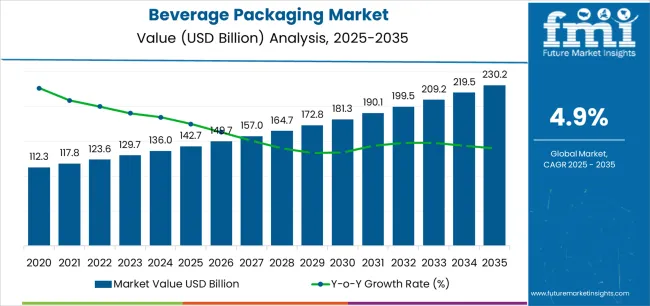
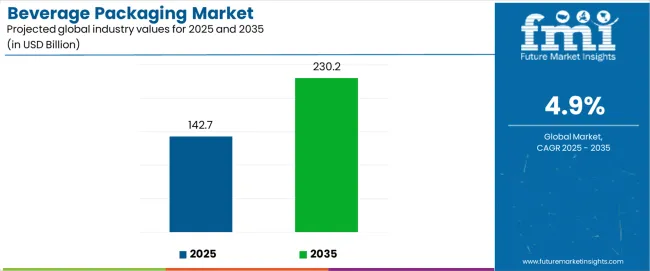
| Metric | Value |
|---|---|
| Estimated Value in (2025E) | USD 142.7 billion |
| Forecast Value in (2035F) | USD 230.2 billion |
| Forecast CAGR (2025 to 2035) | 4.9% |
Market expansion is being supported by the increasing global consumption of packaged beverages and the corresponding need for packaging solutions that can provide superior product protection, extended shelf life capabilities, and enhanced consumer convenience while enabling brand differentiation and efficient distribution across various retail and foodservice applications. Modern beverage producers and bottling operations are increasingly focused on implementing packaging solutions that can preserve product freshness, prevent contamination and oxidation, and provide consistent quality performance throughout complex supply chains spanning production facilities to end consumers. Beverage packaging's proven ability to deliver exceptional barrier protection against moisture and oxygen, enable temperature stability during storage and transportation, and support effective brand communication make them essential packaging formats for contemporary beverage manufacturing and distribution operations.
The growing emphasis on premiumization and product differentiation is driving demand for beverage packaging that can support innovative bottle shapes, enhanced label graphics, and distinctive closure systems that improve brand recognition and consumer appeal. Manufacturers' preference for packaging that combines effective product protection with visual aesthetics and functional convenience is creating opportunities for advanced packaging implementations. The rising influence of health-conscious consumers and functional beverage categories is also contributing to increased demand for packaging that can provide tamper-evidence features, portion control capabilities, and reliable performance across diverse beverage formulations.
The beverage packaging market is poised for rapid growth and transformation. As industries across soft drinks, bottled water, alcoholic beverages, functional drinks, and dairy beverages seek packaging that delivers exceptional product protection, freshness preservation, and consumer convenience, advanced packaging technologies are gaining prominence not just as commodity containers but as strategic enablers of brand value and market differentiation.
Rising health beverage consumption in Asia-Pacific and expanding premium bottled water markets globally amplify demand, while manufacturers are leveraging innovations in barrier coating technologies, lightweight bottle designs, and intelligent packaging features with connectivity capabilities.
Pathways like smart packaging with digital engagement, advanced barrier technologies for extended shelf life, and application-specific customization promise strong margin uplift, especially in high-value segments. Geographic expansion and vertical integration will capture volume, particularly where local production capabilities and distribution network efficiency are critical. Regulatory frameworks around food safety requirements, recycling mandates, beverage quality standards, and tamper-evident packaging give structural support.
The market is segmented by material type, packaging type, beverage type, capacity, closure type, and region. By material type, the market is divided into plastic, glass, metal, paperboard, and others. By packaging type, it covers bottles, cans, cartons, pouches, and others. By beverage type, the market is segmented into carbonated soft drinks, bottled water, alcoholic beverages, fruit juices & nectars, energy & sports drinks, dairy beverages, and others. The capacity includes small (below 250ml), medium (250-750ml), and large (above 750ml). By closure type, it is categorized into screw caps, crown caps, sports caps, flip-top caps, and others. Regionally, the market is divided into North America, Europe, East Asia, South Asia & Pacific, Latin America, and the Middle East & Africa.

The plastic segment is projected to account for 39.5% of the beverage packaging market in 2025, reaffirming its position as the leading material category. Beverage producers and bottling operations increasingly utilize plastic packaging for its superior lightweight characteristics when processed through advanced blow molding technologies, excellent design flexibility capabilities, and cost-effectiveness in applications ranging from carbonated soft drinks to bottled water and functional beverage products. Plastic packaging technology's advanced barrier coating capabilities and consistent production scalability directly address the industrial requirements for efficient high-speed bottling in volume production environments.
This material segment forms the foundation of modern beverage distribution operations, as it represents the packaging type with the greatest versatility and established market demand across multiple beverage categories and regional markets. Manufacturer investments in enhanced oxygen barrier technologies and lightweight bottle optimization continue to strengthen adoption among beverage producers and bottling facilities. With companies prioritizing production efficiency and distribution cost optimization, plastic packaging aligns with both performance requirements and economic efficiency objectives, making them the central component of comprehensive beverage packaging strategies.
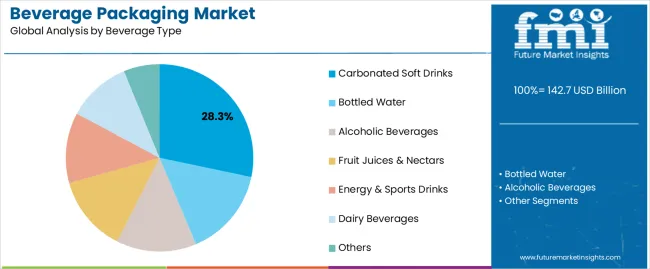
Carbonated soft drinks applications are projected to represent 28.3% of beverage packaging demand in 2025, underscoring their critical role as the primary beverage category utilizing advanced packaging solutions for carbonation retention, pressure resistance, and brand presentation throughout retail distribution channels. Soft drink manufacturers prefer specialized packaging for their exceptional gas barrier properties, structural integrity under internal pressure, and ability to maintain product freshness while ensuring consistent carbonation levels during extended shelf life periods. Positioned as essential packaging formats for carbonated beverage operations, these containers offer both functional performance advantages and brand visibility benefits.
The segment is supported by continuous innovation in lightweight PET bottle technologies and the growing availability of specialized closure systems that enable carbonation preservation with enhanced consumer convenience and tamper-evident security features. Additionally, soft drink manufacturers are investing in high-speed filling line automation systems to support large-volume packaging operations and production efficiency. As global soft drink consumption becomes more prevalent and premium carbonated beverage categories expand, carbonated soft drinks applications will continue to dominate the end-use market while supporting advanced packaging innovation utilization and bottling automation strategies.
The beverage packaging market is advancing rapidly due to increasing demand for convenient ready-to-drink formats and growing adoption of advanced packaging solutions that provide superior product protection, extended shelf life capabilities, and enhanced consumer engagement while enabling efficient production automation across diverse beverage manufacturing and distribution applications. However, the market faces challenges, including regulatory pressures regarding material recyclability, competition from alternative packaging formats, and the need for specialized barrier technology investments. Innovation in intelligent packaging features and lightweighting material development continues to influence product development and market expansion patterns.
The growing adoption of digital printing capabilities, QR code integration, and near-field communication technologies is enabling manufacturers to produce smart packaging with superior consumer engagement functionalities, enhanced brand protection properties, and product authentication capabilities. Advanced intelligent systems provide improved supply chain traceability while allowing more effective marketing communication and consistent anti-counterfeiting performance across various distribution channels and retail applications. Manufacturers are increasingly recognizing the competitive advantages of connected packaging capabilities for brand differentiation and premium market positioning.
Modern beverage packaging producers are incorporating advanced structural design optimization, material thickness reduction technologies, and computer-aided engineering analysis to enhance material efficiency, enable transportation cost reduction, and deliver value-added solutions to beverage brands and bottling customers. These technologies improve operational economics while enabling new performance capabilities, including reduced carbon footprint, maintained structural integrity, and enhanced handling convenience. Advanced lightweighting integration also allows manufacturers to support large-scale production operations and cost optimization beyond traditional heavy-wall packaging approaches.
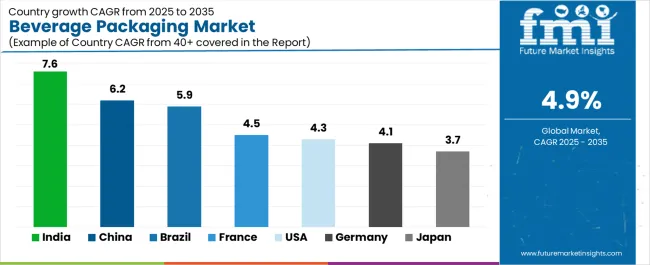
| Country | CAGR (2025-2035) |
|---|---|
| India | 7.6% |
| China | 6.2% |
| USA | 4.3% |
| Brazil | 5.9% |
| Germany | 4.1% |
| Japan | 3.7% |
| France | 4.5% |
The beverage packaging market is experiencing strong growth globally, with India leading at a 7.6% CAGR through 2035, driven by the expanding bottled water consumption, growing soft drink market penetration, and significant investment in beverage manufacturing infrastructure development. China follows at 6.2%, supported by rapid urbanization driving packaged beverage demand, increasing premium beverage consumption, and growing domestic bottling capabilities. The USA shows growth at 4.3%, emphasizing functional beverage innovation and craft beverage packaging development. Brazil records 5.9%, focusing on juice market expansion and alcoholic beverage packaging growth. Germany demonstrates 4.1% growth, prioritizing premium beer packaging standards and advanced beverage production excellence. Japan exhibits 3.7% growth, emphasizing precision manufacturing and quality beverage container production. France shows 4.5% growth, supported by wine packaging demand and premium beverage concentrate.
The report covers an in-depth analysis of 40+ countries top-performing countries are highlighted below.
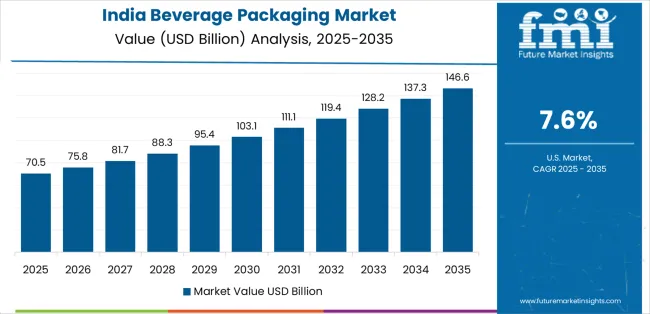
Revenue from beverage packaging in India is projected to exhibit exceptional growth with a CAGR of 7.6% through 2035, driven by expanding middle-class consumption and rapidly growing packaged beverage demand supported by government initiatives promoting manufacturing development and infrastructure modernization. The country's strong position in bottled water growth and increasing investment in beverage production facilities are creating substantial demand for diverse packaging solutions. Major beverage brands and bottling companies are establishing comprehensive packaging procurement capabilities to serve both domestic consumption demand and export market opportunities.
Revenue from beverage packaging in China is expanding at a CAGR of 6.2%, supported by the country's massive beverage consumption market, expanding health-conscious consumer base, and increasing adoption of premium beverage products. The country's government initiatives promoting quality standards and growing urban population are driving requirements for sophisticated beverage packaging capabilities. International brands and domestic manufacturers are establishing extensive production and distribution capabilities to address the growing demand for packaged beverage products.
Revenue from beverage packaging in the USA is expanding at a CAGR of 4.3%, supported by the country's advanced beverage manufacturing capabilities, strong emphasis on packaging innovation technologies, and robust demand for functional and craft beverage products across diverse consumer segments. The nation's mature beverage industry and innovation-focused operations are driving sophisticated packaging systems throughout the supply chain. Leading manufacturers and technology providers are investing extensively in intelligent packaging features and lightweight bottle technologies to serve both domestic and international markets.
Revenue from beverage packaging in Brazil is growing at a CAGR of 5.9%, driven by the country's expanding juice consumption, growing soft drink market, and increasing investment in beverage manufacturing infrastructure development. Brazil's large consumer population and commitment to beverage industry expansion are supporting demand for diverse packaging solutions across multiple beverage segments. Manufacturers are establishing comprehensive production capabilities to serve the growing domestic market and regional distribution opportunities.
Revenue from beverage packaging in Germany is expanding at a CAGR of 4.1%, supported by the country's brewing industry leadership, advanced manufacturing capabilities, and strategic focus on quality-oriented beverage packaging. Germany's engineering excellence and beverage production innovation are driving demand for packaging in beer bottling, mineral water distribution, and premium beverage applications. Manufacturers are investing in comprehensive quality control capabilities to serve both domestic beverage producers and international export markets.
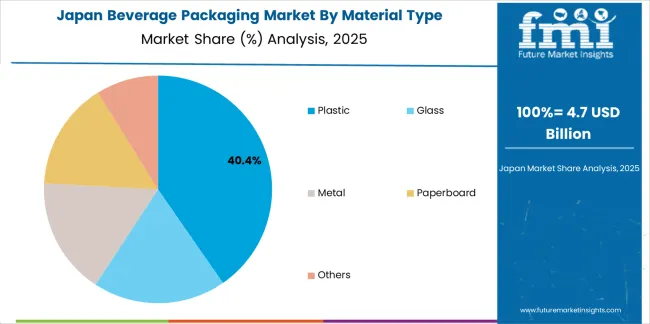
Revenue from beverage packaging in Japan is growing at a CAGR of 3.7%, driven by the country's expertise in precision manufacturing, emphasis on quality control, and strong position in ready-to-drink beverage and specialty product packaging. Japan's established packaging technology capabilities and commitment to innovation are supporting investment in advanced production technologies throughout major manufacturing centers. Industry leaders are establishing comprehensive quality assurance systems to serve domestic beverage producers and export-oriented manufacturers.
Revenue from beverage packaging in France is expanding at a CAGR of 4.5%, supported by the country's wine industry concentration, growing premium beverage sector, and strategic position in European beverage markets. France's prestige beverage capabilities and integrated distribution infrastructure are driving demand for high-quality packaging in wine bottling, mineral water production, and specialty beverage applications. Leading manufacturers are investing in specialized capabilities to serve the stringent requirements of wine producers and premium beverage industries.
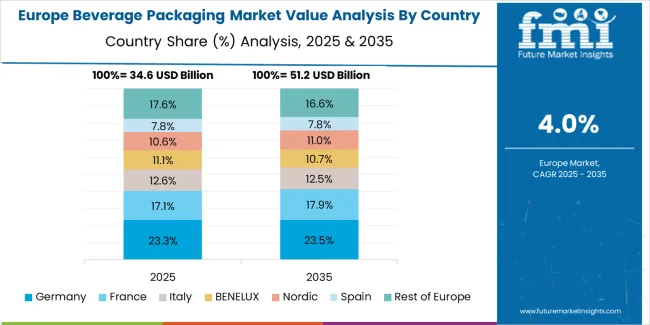
The beverage packaging market in Europe is projected to grow from USD 38.4 billion in 2025 to USD 64.8 billion by 2035, registering a CAGR of 5.3% over the forecast period. Germany is expected to maintain its leadership position with a 26.5% market share in 2025, adjusting slightly to 26.8% by 2035, supported by its strong beverage manufacturing industry, advanced bottling automation capabilities, and comprehensive brewing sector serving diverse packaging applications across Europe.
France follows with a 17.8% share in 2025, projected to reach 18.2% by 2035, driven by robust demand for wine packaging, mineral water bottling, and premium beverage containers, combined with established beverage production infrastructure and specialty packaging expertise. The United Kingdom holds a 15.3% share in 2025, expected to reach 15.6% by 2035, supported by strong soft drink market and growing craft beverage activities. Italy commands a 13.7% share in 2025, projected to reach 14.1% by 2035, while Spain accounts for 10.2% in 2025, expected to reach 10.6% by 2035. The Netherlands maintains a 5.8% share in 2025, growing to 6.0% by 2035. The Rest of Europe region, including Nordic countries, Eastern Europe, Belgium, Poland, and other nations, is anticipated to maintain momentum, with its collective share moving from 10.7% to 8.7% by 2035, attributed to increasing beverage production in Eastern Europe and growing premium beverage consumption in Nordic countries implementing advanced packaging programs.
The beverage packaging market features 10–15 players with moderate concentration, where the top three companies collectively hold around 50–55% of global market share, driven by advanced production technologies, innovative designs, and long-term relationships with beverage producers across soft drinks, alcoholic beverages, and bottled water. The leading company, Amcor plc, commands 18% of the market share, supported by its extensive portfolio of flexible and rigid beverage packaging solutions, strong sustainability initiatives, and a global customer base. Competition centers on material performance, sustainability, product differentiation, and supply chain efficiency rather than price alone.
Market leaders such as Amcor plc, Berry Global Inc., and Ball Corporation maintain their dominant positions by offering high-quality packaging solutions that ensure product protection, consumer convenience, and strong branding opportunities. These companies leverage advanced technologies such as lightweight packaging, recyclability, and innovative closures, helping to meet growing demand for sustainable and eco-friendly packaging solutions.
Challenger companies like Crown Holdings Inc., Ardagh Group S.A., and Tetra Pak International S.A. focus on specialized packaging formats, such as aluminum cans, glass bottles, and aseptic cartons, catering to the diverse needs of the beverage industry.
Additional competition arises from Silgan Holdings Inc., Owens-Illinois Inc., Graham Packaging Company, and Consolidated Container Company, which offer cost-effective, customizable packaging solutions and strong regional production capabilities.
| Items | Values |
|---|---|
| Quantitative Units (2025) | USD 142.7 billion |
| Material Type | Plastic, Glass, Metal, Paperboard, Others |
| Packaging Type | Bottles, Cans, Cartons, Pouches, Others |
| Beverage Type | Carbonated Soft Drinks, Bottled Water, Alcoholic Beverages, Fruit Juices & Nectars, Energy & Sports Drinks, Dairy Beverages, Others |
| Capacity | Small (Below 250ml), Medium (250-750ml), Large (Above 750ml) |
| Closure Type | Screw Caps, Crown Caps, Sports Caps, Flip-Top Caps, Others |
| Regions Covered | North America, Europe, East Asia, South Asia & Pacific, Latin America, Middle East & Africa |
| Countries Covered | United States, Canada, United Kingdom, Germany, France, China, Japan, South Korea, India, Brazil, Australia and 40+ countries |
| Key Companies Profiled | Amcor plc, Berry Global Inc., Ball Corporation, Crown Holdings Inc., Ardagh Group S.A., Tetra Pak International S.A., Silgan Holdings Inc., Owens-Illinois Inc., Graham Packaging Company, Consolidated Container Company |
| Additional Attributes | Dollar sales by material type and beverage type category, regional demand trends, competitive landscape, technological advancements in barrier systems, lightweight bottle development, intelligent packaging innovation, and supply chain integration |
The global beverage packaging market is estimated to be valued at USD 142.7 billion in 2025.
The market size for the beverage packaging market is projected to reach USD 230.2 billion by 2035.
The beverage packaging market is expected to grow at a 4.9% CAGR between 2025 and 2035.
The key product types in beverage packaging market are plastic, glass, metal, paperboard and others.
In terms of beverage type, carbonated soft drinks segment to command 28.3% share in the beverage packaging market in 2025.






Our Research Products

The "Full Research Suite" delivers actionable market intel, deep dives on markets or technologies, so clients act faster, cut risk, and unlock growth.

The Leaderboard benchmarks and ranks top vendors, classifying them as Established Leaders, Leading Challengers, or Disruptors & Challengers.

Locates where complements amplify value and substitutes erode it, forecasting net impact by horizon

We deliver granular, decision-grade intel: market sizing, 5-year forecasts, pricing, adoption, usage, revenue, and operational KPIs—plus competitor tracking, regulation, and value chains—across 60 countries broadly.

Spot the shifts before they hit your P&L. We track inflection points, adoption curves, pricing moves, and ecosystem plays to show where demand is heading, why it is changing, and what to do next across high-growth markets and disruptive tech

Real-time reads of user behavior. We track shifting priorities, perceptions of today’s and next-gen services, and provider experience, then pace how fast tech moves from trial to adoption, blending buyer, consumer, and channel inputs with social signals (#WhySwitch, #UX).

Partner with our analyst team to build a custom report designed around your business priorities. From analysing market trends to assessing competitors or crafting bespoke datasets, we tailor insights to your needs.
Supplier Intelligence
Discovery & Profiling
Capacity & Footprint
Performance & Risk
Compliance & Governance
Commercial Readiness
Who Supplies Whom
Scorecards & Shortlists
Playbooks & Docs
Category Intelligence
Definition & Scope
Demand & Use Cases
Cost Drivers
Market Structure
Supply Chain Map
Trade & Policy
Operating Norms
Deliverables
Buyer Intelligence
Account Basics
Spend & Scope
Procurement Model
Vendor Requirements
Terms & Policies
Entry Strategy
Pain Points & Triggers
Outputs
Pricing Analysis
Benchmarks
Trends
Should-Cost
Indexation
Landed Cost
Commercial Terms
Deliverables
Brand Analysis
Positioning & Value Prop
Share & Presence
Customer Evidence
Go-to-Market
Digital & Reputation
Compliance & Trust
KPIs & Gaps
Outputs
Full Research Suite comprises of:
Market outlook & trends analysis
Interviews & case studies
Strategic recommendations
Vendor profiles & capabilities analysis
5-year forecasts
8 regions and 60+ country-level data splits
Market segment data splits
12 months of continuous data updates
DELIVERED AS:
PDF EXCEL ONLINE
Beverage Packaging Equipment Market Size and Share Forecast Outlook 2025 to 2035
Beverage Packaging Machine Market Size and Share Forecast Outlook 2025 to 2035
Market Share Distribution Among Beverage Packaging Companies
Ultra Clean Beverage Packaging Machine Market Analysis Size and Share Forecast Outlook 2025 to 2035
Sanitary Food & Beverage Packaging Market Size and Share Forecast Outlook 2025 to 2035
Plastic Packaging For Food and Beverage Market Size and Share Forecast Outlook 2025 to 2035
Anti-Counterfeit Packaging for Food & Beverages Market Growth - Forecast 2025 to 2035
Beverage Metal Can Market Size and Share Forecast Outlook 2025 to 2035
Beverage Carrier Market Size and Share Forecast Outlook 2025 to 2035
Beverage Cartoners Market Size and Share Forecast Outlook 2025 to 2035
Beverage Filter Paper Market Size and Share Forecast Outlook 2025 to 2035
Beverage Ingredients Market Analysis - Size and Share Forecast Outlook 2025 to 2035
Beverage Clouding Agent Market Size and Share Forecast Outlook 2025 to 2035
Beverage Premix Market Size and Share Forecast Outlook 2025 to 2035
Beverage Acidulants Market Size and Share Forecast Outlook 2025 to 2035
Beverage Refrigeration Market Size and Share Forecast Outlook 2025 to 2035
Beverage Tester Market Size and Share Forecast Outlook 2025 to 2035
Beverage Dispenser Market Size and Share Forecast Outlook 2025 to 2035
Beverage Container Market Size and Share Forecast Outlook 2025 to 2035
Beverage Can Ends Market Size and Share Forecast Outlook 2025 to 2035

Thank you!
You will receive an email from our Business Development Manager. Please be sure to check your SPAM/JUNK folder too.
Chat With
MaRIA